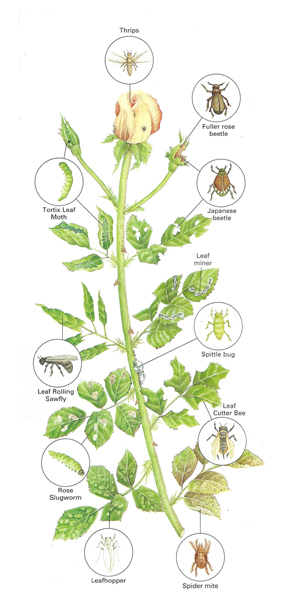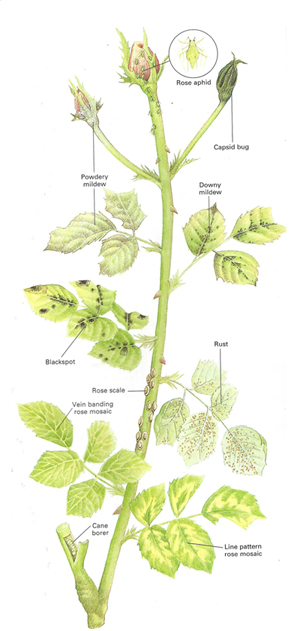by Dr. Tommy Cairns, Ortho’s All About Roses, 1999
[with updates from the ARS Consulting Rosarian Manual]
There are three main categories of pests to watch out for – various insects, spider mites, and fungal diseases. This section deals mainly with a visual identification scheme and some suggestions for control.

JAPANESE BEETLE, FULLER ROSE BEETLE: These are two beetles that will indiscriminately eat parts of the foliage, sometimes the flower parts. While beetles can be picked off the bush by hand [drop in a bucket of water with a drop of dish soap*], their larvae are subterranean dwellers that can be disposed of with a soil drench of an appropriate insecticide.
TORTIX LEAF MOTH: This insect lays eggs on the underside of foliage and rolls the leaf into a protective cover, using a silken thread to hold the foliage in a cocoon-like structure. This allows the developing caterpillar to feed. Remove and destroy foliage.
LEAF MINER: This insect is easily spotted on the foliage by the appearance of irregular white chain-like blisters containing its grub. Foliage should be removed and discarded to prevent further infection.
LEAF ROLLING SAWFLY: This fly lays its eggs in the leaf margins with the leaf rolling up into a strange looking cocoon-like structure. At this stage it is best to remove the leaf and destroy the grubs inside; otherwise the colony will quickly spread.
SPlTTLE BUG: This small, greenish-yellow insect always hides inside a circular mass of white foam on the surface of new stems, usually during the development of the first bloom cycle in early spring. A strong jet spray of water will remove the foam and the insect.
ROSE SLUGWORM: When you detect new foliage with a skeletonized pattern indicating the foliage has been eaten (but not the vein structure), then chances are the rose slugworm has been at work. It is best to remove the infected foliage or spray regularly with an insecticide.
LEAF CUTTER BEE: Regarded as a beneficial insect, the leaf cutter carves out semicircular portions of foliage as nest tunnels and fodder for its young. Live with the damage, for this insect is a natural predator for other pests.
LEAFHOPPER: As its name implies, this very small yellowish-green insect jumps on the undersides of foliage to feast, often leaving its white skin behind. The damage caused by this insect can often result in defoliation. Use of an insecticide will prevent it from establishing a strong colony.

ROSE APHID: Number one insect enemy in the rose garden is undoubtedly the aphid (often referred to as greenfly). The rose aphid is a small, green, soft-bodied
insect (about 1/16 inch long) that can be found in large colonies, particularly on the first lush spring growth, sucking the sap from the stems via puncture holes. For control, they can be washed off the stems with water or sprayed with an insecticide.
CAPSID BUG: This insect is easily spotted on the buds as it is usually bright green. It feeds on buds and foliage, resulting in distortion or wilting. An application of an
insecticide will solve the problem.
POWDERY MILDEW: This fungus feeds on roses by embedding its own living structure into the cellular just below the epidermis. It then feeds on the sap, extending its structure on the surface. Control using a fungicide. The waxy coating of some rose leaves provides a good barrier to the fungus. [Good air movement and sanitation in the garden will reduce the primary source of inoculum.*]
DOWNY MILDEW: Perhaps the most serious fungus to invade the rose garden is downy mildew, a big brother to powdery mildew. It can defoliate a rose bush and continue to survive on the canes themselves. Control preventively with a fungicide. Practice good sanitation; pick up fallen leaves and prunings and dispose of them in the trash.
BLACKSPOT: This fungus causes circular black spots [having a feathery edge*] on the surface of leaves. It tends to thrive in warm [75 degrees F *], wet climates with high humidity. Control with a fungicide. Practice good sanitation; pick up fallen leaves and place in trash; do not compost them.
ROSE SCALE: This insect hides under gray scales or shells normally on old canes or stems. It feeds by sucking the sap and hence weakens the plant. If localized, it can often be removed with your fingernail or spraying with an insecticide [or horticultural oil spray*].
RUST: This is another fungus that can invade garden, especially when moisture levels are high. It grows on the undersides of the foliage in little red clusters. Rust is destroyed by an application of a suitable fungicide. [Rust is more serious in western US, it usually will not over-winter in eastern US.*]
VIRUS: Two viral infections sometimes attack roses, appearing as yellow or cream veining that gives the foliage a variegated look. Vein banding mosaic is not a serious problem. Line pattern rose mosaic, however, can weaken the plant and cause death. Remove and destroy plants with either of these two infections to avoid spread in the garden.
CANE BORER: This insect is the maggot of the eggs by sawflies or carpenter bees deep in the freshly cut cane of the rose after pruning. The telltale sign of cane borer is the neatly punctured hole visible on top of the cane. To remove the pest, cut several down the cane until there are no longer signs the maggot or pith-eaten core.
Extracted from Ortho’s All About Roses, Monsanto Company copyright © 1999, Meredith Corporation copyright © 1999
*Extracted from Consulting Rosarian Manual, American Rose Society, copyright © 2016.
Ortho ® is a registered trademark of the Scotts Company LLC.
